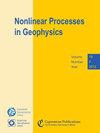Extraction of periodic signals in Global Navigation Satellite System (GNSS) vertical coordinate time series using the adaptive ensemble empirical modal decomposition method
IF 2.4
4区 地球科学
Q3 GEOSCIENCES, MULTIDISCIPLINARY
引用次数: 0
Abstract
Abstract. Empirical modal decomposition (EMD) is an efficient tool for extracting a signal from stationary or non-stationary time series and is enhanced in stability and robustness by ensemble empirical mode decomposition (EEMD). Adaptive EEMD further improves computational efficiency through adaptability in the white noise amplitude and set average number. However, its effectiveness in the periodic signal extraction in Global Navigation Satellite System (GNSS) coordinate time series regarding the inevitable missing data and offset issues has not been comprehensively validated. In order to thoroughly investigate their impacts, we simulated 5 years of daily time series data with different missing data percentages or a different number of offsets and conducted them 300 times for each simulation. The results show that high accuracy could reach the overall random missing rate below 15 % and avoid consecutive misses exceeding 30 d. Meanwhile, offsets should be corrected in advance regardless of their magnitudes. The analysis of the vertical components of 13 stations within the Australian Global Sea Level Observing System (GLOSS) monitoring network demonstrates the advantage of adaptive EEMD in revealing the time-varying characteristics of periodic signals. From the perspectives of correlation coefficients (CCs), root mean square error (RMSE), power spectral density indices (κ) and signal-to-noise ratio (SNR), the means for adaptive EEMD are 0.36, 0.81, −0.18 and 0.48, respectively, while for least squares (LS), they are 0.27, 0.86, −0.50 and 0.23. Meanwhile, a significance test of the residuals further substantiates the effectiveness in periodic signal extraction, which shows that there is no annual signal remaining. Also, the longer the series, the higher the accuracy of the reasonable extracted periodic signal concluded via the significance test. Moreover, driving factors are more effectively facilitated by the time-varying periodic characteristics compared with the constant periodic signal derived by LS. Overall, the application of adaptive EEMD could achieve high accuracy in analyzing GNSS time series, but it should be based on properly dealing with missing data and offsets.利用自适应集合经验模态分解法提取全球导航卫星系统(GNSS)垂直坐标时间序列中的周期信号
摘要经验模态分解(EMD)是从静态或非静态时间序列中提取信号的有效工具,而集合经验模态分解(EEMD)增强了其稳定性和鲁棒性。自适应 EEMD 通过对白噪声振幅和集合平均数的自适应,进一步提高了计算效率。然而,对于全球导航卫星系统(GNSS)坐标时间序列中不可避免的数据缺失和偏移问题,其在周期信号提取中的有效性尚未得到全面验证。为了深入研究它们的影响,我们模拟了 5 年的每日时间序列数据,并以不同的缺失数据百分比或不同的偏移量进行了模拟,每次模拟进行 300 次。结果表明,高精度可以使总体随机缺失率低于 15%,并避免连续缺失超过 30 d。同时,无论偏移量有多大,都应提前校正。对澳大利亚全球海平面观测系统(GLOSS)监测网络中 13 个站点的垂直分量进行的分析表明,自适应 EEMD 在揭示周期信号的时变特征方面具有优势。从相关系数(CC)、均方根误差(RMSE)、功率谱密度指数(κ)和信噪比(SNR)的角度来看,自适应 EEMD 的均值分别为 0.36、0.81、-0.18 和 0.48,而最小二乘法(LS)的均值分别为 0.27、0.86、-0.50 和 0.23。同时,残差的显著性检验进一步证实了周期信号提取的有效性,表明没有剩余的年度信号。而且,序列越长,通过显著性检验得出的合理提取周期信号的准确性越高。此外,与 LS 得出的恒定周期信号相比,时变周期特征能更有效地促进驱动因素。总体而言,应用自适应 EEMD 可以实现高精度的 GNSS 时间序列分析,但应建立在妥善处理缺失数据和偏移的基础上。
本文章由计算机程序翻译,如有差异,请以英文原文为准。
求助全文
约1分钟内获得全文
求助全文
来源期刊

Nonlinear Processes in Geophysics
地学-地球化学与地球物理
CiteScore
4.00
自引率
0.00%
发文量
21
审稿时长
6-12 weeks
期刊介绍:
Nonlinear Processes in Geophysics (NPG) is an international, inter-/trans-disciplinary, non-profit journal devoted to breaking the deadlocks often faced by standard approaches in Earth and space sciences. It therefore solicits disruptive and innovative concepts and methodologies, as well as original applications of these to address the ubiquitous complexity in geoscience systems, and in interacting social and biological systems. Such systems are nonlinear, with responses strongly non-proportional to perturbations, and show an associated extreme variability across scales.
 求助内容:
求助内容: 应助结果提醒方式:
应助结果提醒方式:


